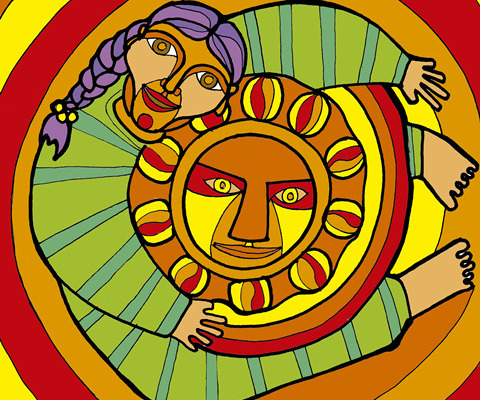Guidelines on how to apply a digital method to the main four different learning styles
Lesson 1: The main four learning styles and the digital method Fairy tales-background
As presented in Chapter 1, the different learning types can be grouped into four main categories: Visual, Auditory, Kinesthetic learners and Reading/writing learners.
In the following, the digital method "fairy tale" is being adapted to each of these categories.
The general idea behind the digital method "fairy tale":
Fairy tales are a significant and very old text genre in the oral tradition and occur in all cultural circles. They present a perfect medium to use amongst participants who wish to learn and share more about each other's cultures. Besides, similarities can often be found in the morality of fairy tales from diverse cultures. This method can be used via online exchange, presence exchange or listened to in a podcast format.
Bulgarian fairy tale 2: The Villager and an eagle
Example from Bulgaria: Villager and an eagle
In this Bulgarian fable, a villager sees an eagle caught in a trap. The villager has great respect for eagles and therefore helps to set it free. A while later, the villager sits on a wall. The wall is about to collapse, which the villager doesn't know. The eagle sees this and decides to steal the villager's hat. The villager angrily runs after the eagle, feels bitterness for he had freed the eagle earlier and throws stones after the eagle to get his hat back. The eagle drops the hat into the hand of the villager. Exactly at that moment, the wall on which the villager sat before collapses. The villager now understands that he would have been crushed by the wall.
Moral: Before you attack someone for doing something that temporarily annoys you, wait to see if it's to your advantage. Unexpected gestures also happen.
Lesson 3: The main four learning styles and the digital method Fairy tales-proposal for adaptation
Auditory:
This digital method is originally intended be a podcast. The learners are able to listen to different fairy tales from diverse cultures in the native language, as well as in English and to research for fairy tales from their own culture and record themselves narrating it.
In an online or presence exchange, this method can be adopted to a live scenario where small groups of learners present their chosen fairy tales to the other groups, again in both their native and English language.
In the next step, the moral can be discussed with the group and similar fairy tales from other cultures might come up.
Reading/writing learners:
The accompanied text to the fairy tale can be used for the reading and writing learners. After the learners have read and understood the fairy tale, they could be asked to search for a similar fairy tale in their culture and to write it down. A creative writing task could be to rewrite the fairy tale while applying it to their own culture or using different characters or even rewriting the story itself, while still reaching the same moral in the end.
Visual:
For those learners who tend to be drawn to visual learning, the fairy tale can be adapted to video, PowerPoint or comic format. While reading the text or listening to the fairy tale, images can accompany the process. In the next step, the learners may be asked to create a comic that presents either the fairy tale of the villager and an eagle or one from their own cultures. Another option is to creatively adapt the fairy tale to PowerPoint by using images. The video format is more advanced and more time intense. Possible formats can be sto-motion videos or short theater play (could use the theater script - see next category). If comics or PowerPoints have been created, these can also be used to create a video, accompanied by the narrator who tells the fairy tale.
Kinesthetic learners:
To apply the fairy tales’ method to the Kinesthetic learners, those who best learn through experience, experiments and an overall hands-on approach, the fairy tale could be presented in a short theater play. For this a short script is needed with the following positions: Narrator, the villager and the eagle. Be aware of utensils needed for the play, in this case a chair or something similar to present the wall and a hat or cap. Each actor knows their role and text. To fully experience the moral behind this fairy tale, it would be fun if the villager didn't know that the wall collapses later on.
Lesson 4: Conclusions
The adaptation of a digital method to the main four learning styles is an important step in the inclusive teaching. It is a creative process of using different formats while reaching the same learning goals. Although it can be more time intense, the results can be shared between the different learning types, and all learners can benefit to the greatest extent, especially considering that mixes of different learning styles, with the predominance of one or another, are frequently demonstrated by one and the same person. Learning preference also may change over time, which means that being prepared to propose adaptations and make the access to and the delivery of the training content flexible and varied is universally beneficial. Thus, for example, the theater script could be written by the reading/writing learners and then used by the kinesthetic learners for their play. The theater play performed can be filmed and then used by the visual learners. The spoken words during the performance enhance the learning experience of auditory learners. There are many creative ways to connect the produced content.

